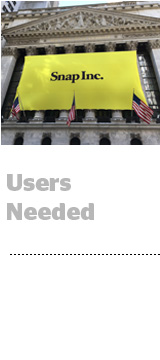
Snap again came in below analysts’ expectations for its Q2 earnings announced on Thursday.
Year-over-year, revenue grew 153% to $181.7 million in Q2 and 200% to $331 million for the half year. Quarter-over-quarter, revenue was up roughly 21%. Analysts expected Q2 revenue to clock in at $186 million.
Daily active users (DAUs) grew 21% year-over-year from 143 million to 173 million, but only 4% sequentially, by 7.3 million users.
Despite these figures, CEO Evan Spiegel told investors that user growth “remains solid.”
“Snapchatters visit the platform more frequently and spend more time than ever before,” he said, noting that DAUs create 20 snaps per day, and users spend an average of 30 minutes per day on Snapchat.
Average revenue per user (ARPU) increased 16% sequentially and 109% year-over-year from 50 cents to $1.50. That’s a drop in the bucket compared to Facebook, which reported ARPU at $19.38 for Q2 in the US and Canada.
Ad Platform Push
Advertising revenue on Snap increased 146% year-over-year and 25% sequentially, said chief strategy officer Imran Khan.
Advertisers are warming to Snap’s self-serve solution, launched in January. In Q2, 60% of Snap ad impressions were bought self-serve, more than double from last quarter, Kahn said.
“Our self-service platform will help us not only tap into additional spend, but onboard long-tail and mid-tail advertisers,” he said. “That will be a significant driver for growth.”
Self-serve programmatic is resonating with direct response advertisers in particular. Through the tool, Snap was able to lower the average cost per install for developers by 80%, Khan said.
But Snap still needs to onboard more advertisers to the platform to scale, Khan said. And as it does, pricing continues to fall, said Drew Vollero, Chief Financial Officer at Snap.
Lower CPMs, however, will also lower the barrier to entry for advertisers, Spiegel said.
“Lower pricing is an important driver of growth at this stage because it provides incentive for advertisers to get over the hurdle of learning how to use Snap,” he said.
Product Bets
Snap is hedging its bets on new products to increase engagement – and ultimately inventory – on its platform.
Spiegel pointed to World Lenses, which superimpose augmented reality images on its outward-facing camera, as a way to grow user engagement. Snap’s dancing hotdog World Lens was viewed 1.5 billion times across its user base. Users spend one minute on average with sponsored lenses.
Snap has also doubled the number of original shows on the platform since Q1, and the number of users watching publisher stories increased 30% since last quarter. Snap Maps, launched in June, has increased the amount of content users submit to Snap’s public “Our Story” by 30%, creating more inventory for advertisers.
“Snap Stories views are higher than they’ve ever been,” Khan said. “This is important because it generates more inventory, and we know advertisers have demand for compelling formats like full-screen video Snap ads.”
Snap also touted its 15 measurement partnerships and June acquisition of location data company Placed as a way to prove both the ROI of its products and its commitment to transparency. Snap almost tripled return on ad spend (ROAS) for retail advertisers and outperformed the average ROAS for mobile CPG campaigns by nearly $1.
Despite making strides on its ad product roadmap and proving its performance, Snap needs to add more users to monetize the platform like its competition. The company is still recovering from a net loss of $2.2 billion related to stock-based compensation expenses from its IPO in March.
Stock was down 16.7% in after-hours trading at the time of publication.
This post was syndicated from Ad Exchanger.

More Stories
Comic: Working Hard or Hardly Working?
NZME celebrates 2024 Voyager Media Awards nominations
Squeezing Innovation: CEO Monica McGurk’s Fresh Take at Tropicana